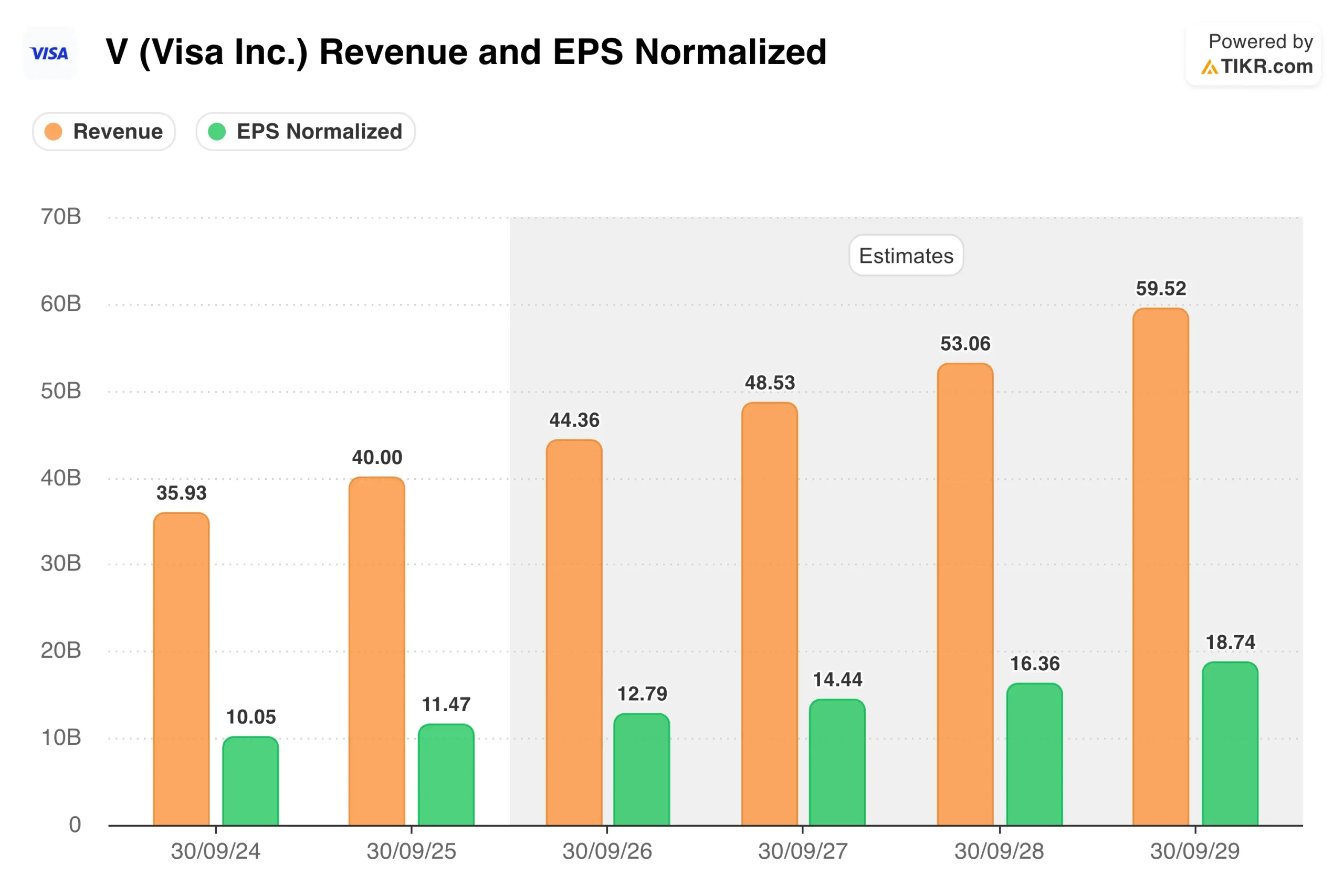Key Stats for Visa Stock
- Price Change for Visa stock: 1%
- Current Share Price as of Oct. 28: $347
- 52-Week High: $371
- $Visa Stock Price Target: $393
Now Live: Discover how much upside your favorite stocks could have using TIKR’s new Valuation Model (It’s free)>>>
What Happened?
Visa (V) stock edged higher in early-market trading after the payments giant reported fiscal fourth-quarter results that showed broad-based strength across its business.
The company posted net revenue of $10.7 billion, up 12% year over year, and earnings per share grew 10%.
For the full fiscal year 2025, Visa generated $40 billion in revenue, up 11%, with EPS climbing 14% to $11.47. Total payment volume hit $14 trillion, up 8% in constant currency, while processed transactions reached 258 billion, up 10% year-over-year.
U.S. payments volume grew 8% in the fourth quarter, accelerating from the prior quarter as both credit and debit card spending rose 8%.
CFO Chris Suh said the company saw “broad-based strength” across spending categories, including retail, services, goods, travel, and fuel.
Cross-border volume remained strong, up 11% with e-commerce growing 13% and travel climbing 10%.
E-commerce now accounts for about 40% of total cross-border volume, and Visa Direct transactions surged 23% to 3.4 billion.

Management provided upbeat guidance for fiscal 2026, expecting adjusted net revenue growth in the low double digits. The company also raised its quarterly dividend by 14%.
See analysts’ growth forecasts and price targets for Visa stock (It’s free!) >>>
What the Market Is Telling Us About Visa Stock
The modest uptick in Visa stock reflects satisfaction with solid results rather than explosive growth. Visa is a mature, stable business that’s executing well across multiple fronts.
The real story is how the company is positioning itself for the future of payments through tokenization, stablecoins, and agentic commerce.
Visa now has more than 16 billion issued tokens, up from 10 billion just in May 2024. CEO Ryan McInerney said the company’s ultimate goal is to tokenize 100% of e-commerce transactions.
Tokens replace sensitive card data with secure digital credentials, making online shopping safer and reducing fraud. The rapid growth in tokenization shows that Visa is becoming more deeply embedded in the digital payments infrastructure.
Contactless payments are also gaining serious traction. Globally, 79% of all face-to-face transactions now use tap-to-pay, up 8 percentage points year-over-year.
In the U.S., that figure stands at 66% of in-person transactions, which improves checkout speed and customer experience while reducing fraud risk.
For Visa stock, the value-added services segment is a key growth driver. Revenue from this business grew 25% in constant currency to $3 billion, driven by issuing solutions, advisory services, and other offerings.
Value-added services now represent roughly 30% of total revenue, up from about 20% a few years ago. This higher-margin business is growing faster than the core payments network, which should support margin expansion over time.

Stablecoins are emerging as another growth opportunity, as Visa has added support for four stablecoins that can be converted to more than 25 fiat currencies.
Monthly volume across Visa’s blockchains for settlement has reached an annualized run rate of $2.5 billion. The company now has over 130 stablecoin-linked card programs in more than 40 countries.
In the fourth quarter alone, stablecoin-linked Visa card spend quadrupled year over year. McInerney emphasized that Visa has facilitated over $140 billion in crypto and stablecoin flows since 2020.
This includes $100 billion in crypto asset purchases using Visa credentials and $35 billion in spending with crypto-backed cards.
Visa is building infrastructure that allows banks to mint and burn their own stablecoins and is integrating stablecoin capabilities into Visa Direct for cross-border money movement.
The company is also investing heavily in what it calls the “next generation of VisaNet”—its core processing platform.
This new architecture uses cloud-ready microservices and open technologies for easier scaling and faster feature deployment.
Notably, over half of the new codebase was built with the help of generative AI, improving development speed and security.
Agentic commerce—where AI agents shop and make purchases on behalf of consumers—is another area where Visa is taking the lead.
McInerney positioned Visa as a standard-setter in this emerging space, just as it was in e-commerce and mobile commerce.
The company recently launched the Visa Trusted Agent Protocol, which helps merchants verify that AI agents are legitimate and authorized to make purchases. McInerney suggested agentic commerce could expand beyond just replacing traditional e-commerce.
AI agents might help consumers discover and buy from a much wider range of merchants based on preferences like price, value, inventory, or delivery speed. That could mean more transactions overall, which benefits Visa.
For Visa stock, the resilient consumer spending backdrop is encouraging. Management noted that higher-spending cardholders drove most of the fourth-quarter growth, consistent with broader U.S. economic trends.
Commercial payments volume grew 7% to $1.8 trillion for the full year. Visa is targeting specific segments, such as business owners and online travel agencies, while expanding its virtual card and spend management solutions for corporate clients.
The company expects fiscal 2026 adjusted operating expenses to grow in the low double digits, in line with revenue growth.
Marketing expenses will be elevated in the second and third quarters due to sponsorships of the Olympic Games and the FIFA World Cup. These high-profile events help drive global brand awareness and cardholder engagement.
Looking ahead, Visa’s “Network of Networks” now has approximately 12 billion endpoints—roughly 4 billion cards, 4 billion bank accounts, and 4 billion digital wallets.
This scale gives Visa a structural advantage as it builds what McInerney calls the “Visa-as-a-Service” stack, enabling anyone in the money movement business to build on Visa’s infrastructure.
Estimate a company’s fair value instantly (Free with TIKR) >>>
How Much Upside Does Visa Stock Have From Here?
With TIKR’s new Valuation Model tool, you can estimate a stock’s potential share price in under a minute.
All it takes is three simple inputs:
- Revenue Growth
- Operating Margins
- Exit P/E Multiple
If you’re not sure what to enter, TIKR automatically fills in each input using analysts’ consensus estimates, giving you a quick, reliable starting point.
From there, TIKR calculates the potential share price and total returns under Bull, Base, and Bear scenarios so you can quickly see whether a stock looks undervalued or overvalued.
See a stock’s true value in under 60 seconds (Free with TIKR) >>>
Looking for New Opportunities?
- See what stocks billionaire investors are buying so you can follow the smart money.
- Analyze stocks in as little as 5 minutes with TIKR’s all-in-one, easy-to-use platform.
- The more rocks you overturn… the more opportunities you’ll uncover. Search 100K+ global stocks, global top investor holdings, and more with TIKR.
Disclaimer:
Please note that the articles on TIKR are not intended to serve as investment or financial advice from TIKR or our content team, nor are they recommendations to buy or sell any stocks. We create our content based on TIKR Terminal’s investment data and analysts’ estimates. Our analysis might not include recent company news or important updates. TIKR has no position in any stocks mentioned. Thank you for reading, and happy investing!







